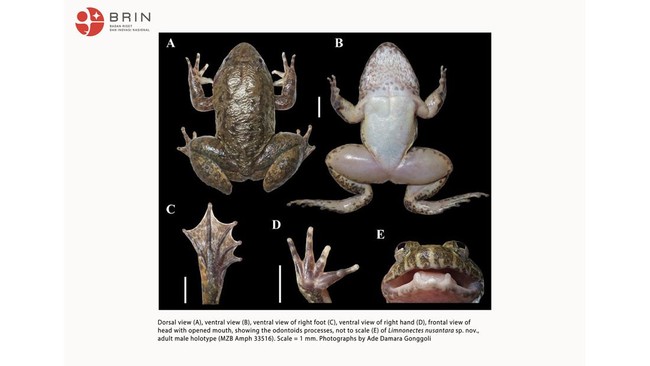Jakarta, Indonesia Sentinel — A team of international and Indonesian researchers has identified two new species of fanged frog in the remote Meratus Mountains of Borneo, shedding light on the island’s rich but underexplored biodiversity.
The discovery was made by researchers from Indonesia’s National Research and Innovation Agency (BRIN), Aichi University of Education, Kyoto University, and Palangkaraya University. The newly identified species have been named Limnonectes maanyanorum sp. nov. and Limnonectes nusantara sp. nov., both of which belong to the Limnonectes kuhlii species complex.
Using an integrative taxonomic approach, the researchers combined detailed morphological studies with molecular analysis of the 16S rRNA gene. Their findings confirmed that the two frogs are distinct evolutionary lineages, formally recognized as new species.
“This discovery is a major contribution to the documentation of herpetofaunal diversity in Borneo and underscores the vital role of the Meratus region in conserving endemic species,” said Prof. Amir Hamidy, a herpetologist with BRIN, in a statement on Tuesday (July 15).
“Habitat destruction, species exploitation, climate change, and emerging diseases remain the greatest threats to the survival of Borneo’s endemic amphibians.”
Limnonectes maanyanorum was found in the Gunung Karasik region of Central Kalimantan. Its name honors the Dayak Maanyan Indigenous community native to the area. Locally, the species is known as “Senteleng Watu,” which translates to “stone frog.”
Meanwhile, Limnonectes nusantara was discovered in the Loksado and Paramasan areas of South Kalimantan. The name “Nusantara” symbolizes Indonesia’s national identity and also references the country’s new capital, currently under development in Borneo. In its native region, the frog is called “Lampinik” by the local Dayak Meratus people.
Both species are medium-sized and notable for their distinctive “fangs”, bony projections found in the lower jaws of the males. They feature fully webbed toes, bumpy skin, and unique body coloration and patterns. The size and shape of the skin nodules and jaw fangs are key characteristics distinguishing the two.
Read Also:
Indonesian Scientists Discover New Blind Lizard Species at Buton Island Sulawesi
Genetic and morphological analyses confirmed that the species form distinct phylogenetic clades with strong statistical support and significant genetic distances from related species. These findings affirm their classification as separate, newly discovered species.
The discovery highlights the urgent need for biodiversity exploration and evidence-based conservation policies in tropical regions, particularly in Borneo, a key area of the Sundaland biodiversity hotspot known for its high level of endemism.
“This discovery demonstrates that Borneo still holds many biological mysteries,” said Prof. Hamidy. “We must continue to explore and study these lesser-known areas.”
The researchers hope the findings will spur further research and help guide conservation priorities in one of the most biologically rich yet threatened regions on Earth.
Their study was published in the peer-reviewed journal Zootaxa (Zootaxa 5575 (3): 387–408) on January 24, 2025, under the title Two new species of fanged frog from Southeastern Borneo, Indonesia.
(Raidi/Agung)

























